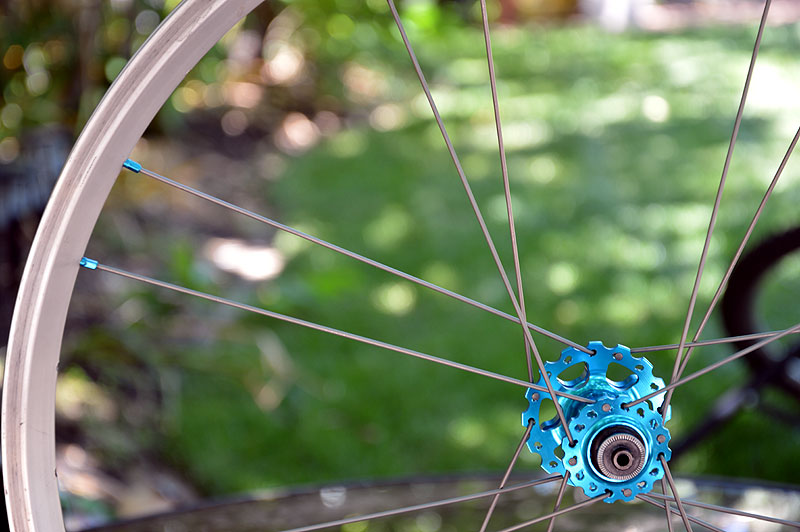Two approaches:
- use every second hole in the hub and rim;
- use paired spoke lacing in the hub and rim.
Every second hole
Using every second hole is pretty straight forward. You simply treat your hub and rims like they have half the number of holes and do your spoke calculations based on that. For example, if you have a 36 hole hub and 36 hole rim and want to use just 18 spokes, then enter 18 spokes in your spoke calculator and get your spoke lengths in the same way as if you were using an actual 18 spoke rim and hub combination.
The problem with the "every second hole" approach, is that most modern rims will have rim holes drilled to match the expected angle of entry of the spoke when laced with the full compliment of spokes. What this means when you use every second hole is that half of the spoke holes you use will now be facing the other hub flange. This results in extra stress for the nipple and spoke at the nipple.
Depending on the rim in question, this may or may not be a problem. Here is an example of a 32 hole rim with which I used a 16 hole hub. For this particular rim (Velocity Aeroheat), the rim spoke hole drilling did not cause too much of a problem.
Paired spoke lacing
One way to avoid the "every second hole" rim drilling problem is to lace the wheel with spokes grouped into pairs that can enter the proper side holes in the rim. This lacing pattern results in two adjacent spoke holes having spokes and then two empty spoke holes.

Calculating the required spoke lengths is a little trickier than the more straight-forward skip every second hole approach. In a nutshell, the paired spoking results in a fractional number of crosses having to be used for the calculation (I used Damon Rinard's Spocalc spreadsheet for all of my spoke length calculations). The trick is, what is that number Fractional Cross number?
If you think about it, the effect of pairing the spokes like I have done in the wheel build above is to move the spokes that cross further apart by one spoke hole. What we need to do is work out what fraction of a normal "cross" that extra skipped spoke hole in the flange will produce.
Here's how to do it:
- decide on the number of spokes you want to use (normally half the number of holes you started with): in my example, 16;
- work out the angle between the holes of the two spokes that will make up a "pair" (Pair Separation Angle). In my case, with 16 holes/flange this means that each "pair" of holes will be 360/16=22.5 deg apart;
- so we are moving our paired spokes an extra 22.5 deg apart. Now lets work out what a standard 16 hole spoke angle separation (Standard Separation Angle) would be: 360/8=45 deg (we divide by 8 because we're concerned with 8 spokes for one flange);
- now we'll work out the Adjusted Angle = Standard Separation Angle + Pair Separation Angle/2: 56.25 degrees
Why divide by 2? Because we want the middle of the "pair" to calculate the fractional cross; - finally, with an Adjusted Angle of 56.5 deg we need to fit 8 of those onto each flange, so the Fractional Cross is worked out as: 56.25deg * 8 / 360deg - 1 = 0.25
Armed with our newly calculated Fractional Cross amount we can figure out what we need to put into our spoke calculator for the number of crosses. For example, the wheel about was built 1x, so the value to put into the spoke calculator is 1.25x . If we were building a 2x wheel, we'd put in 2.25x etc. Just add the Fractional Cross amount to the number of crosses you want.
Note: if you're building something like a 16 spoke spoke wheel you will find it exceedingly difficult to build it 3x. Even 2x can be problematic depending on rim and hub flange diameter.